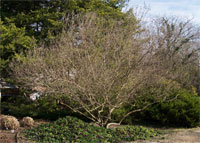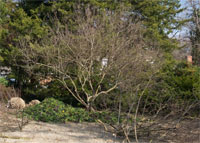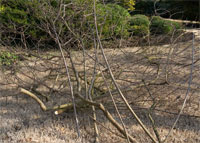From the Sperry Garden – February, 2010
Taming the Wild Vitex

I’ve always contended that we go off and leave many otherwise wonderful landscaping plants, always in search of something new and shiny. Vitex was one of those examples, but Texas landscapers rediscovered it 15 or 20 years ago, and now it’s a mainstream plant, particularly where water conservation is of concern. (That would be most of Texas!)
Vitex agnus-castus (lilac chaste tree, or sometimes casually referred to as "Texas lilac") is actually a large, spreading shrub that grows 15 to 18 feet tall and 20 to 22 feet wide. It produces star-shaped, gray-green leaves that are the perfect backdrop to its grayish-blue flower spikes (which drive swallowtails crazy!).
Vitex needs full or nearly full sun to do its best. Although it’s tolerant of drought, it will grow more quickly and fill in more densely if you’ll keep it damp at most times. Apply a high-nitrogen or all-nitrogen lawn-type fertilizer to keep it vigorous.
No insects or diseases ever bother this plant, so it would appear that our story has reached a conclusion.
Well, not exactly. Like bush roses, vitex plants will be more vigorous if you prune them occasionally to encourage vigorous new shoots. We finally did that to our old friend earlier this month. You can see the "before" and "after" photos, but they really don’t suggest the quantity of "wood" we actually removed.
We started with lower branches that made maintenance difficult. Several of those were 2 to 3 inches in diameter and 10 to12 feet long. We removed any strongly vertical shoots that seemed to disrupt the natural flow of branch growth. Finally, we removed any weak or damaged interior branches, especially those that were rubbing against other branches.
The entire process took only 20 minutes. Curiously, casual observers driving down the county road alongside our property probably won’t even notice that we’ve done anything special to this plant. But, what we’ve accomplished immediately is to create a bed for low flowers beneath it, where we weren’t able to do anything before. And, hopefully we also will benefit from more flowers from the vitex itself, starting as early as this coming spring’s blooms.
Special Note from Texas A&M Horticulture
Our friend, Dr. Jerry Parsons, who worked for his entire career as a research horticulturist with the Texas AgriLife Extension, advocates very significant pruning of vitex, especially in South Texas landscapes. He has told me personally that this severe "deadheading" of the spent flowers will result in rapid regrowth and second and third rounds of blooms in the same season. Click here to link to the TAMU web page.




